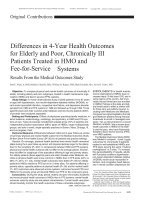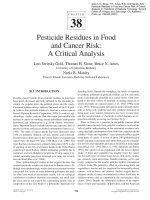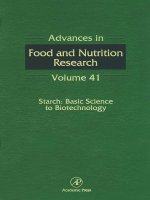ADVANCES IN FOOD AND NUTRITION RESEARCH VOLUME 41 ppt
Bạn đang xem bản rút gọn của tài liệu. Xem và tải ngay bản đầy đủ của tài liệu tại đây (10.83 MB, 217 trang )
ADVANCES
IN
FOOD
AND
NUTRITION
RESEARCH
VOLUME
41
Starch
Basic Science to Biotechnology
ADVISORY BOARD
DOUGLAS ARCHER
Gainesville, Florida
JESSE
F.
GREGORY
I11
Gainesville, Florida
SUSAN
K.
HARLANDER
Minneapolis, Minnesota
DARYL
B.
LUND
New Brunswick, New Jersey
BARBARA
0.
SCHNEEMAN
Dii
vis,
California
SERIES EDITORS
GEORGE
F.
STEWART
(
1948-
1
982)
EMIL
M. MRAK
(1948-1987)
C.
0.
CHICHESTER (1959-1988)
BERNARD
S.
SCHWEIGERT (1984-1988)
JOHN E. KINSELLA (1 989- 1995)
STEVE L. TAYLOR (1995-
)
ADVANCES IN
FOOD
AND
NUTRITION
RESEARCH
VOLUME
41
Starch
Basic Science
to Biotechnology
Edited
by
MIRTA NOEMI SIVAK
JACK PREISS
Department
of
Biochemistry
Michigan State University
East Lansing, Michigan
AND
ACADEMIC PRESS
San
Diego
London Boston
New
York
Sydney Tokyo Toronto
This
book
is
printed
on
acid-free
paper.
@
Copyright
0
1998
by ACADEMIC PRESS
All
Rights Reserved.
No
part of this publication may
be
reproduced or transmitted
in
any form or by any
means. electronic
or
mechanical. including photocopy, recording, or any information
storage and retrieval system. without permission in writing from the Publisher.
The appearance
of
the code at the bottom
of
the first page
of
a chapter
in
this book
indicares the Publisher's consent that copies of
the
chapter may
be
made for
personal or internal use of specific clients. This consent is given on the condition,
however, that the copier pay the stated per copy fee through the Copyright Clearance
Center, Inc.
(222
Rosewood Drive, Danvers, Massachusetts
01923),
for copying
beyond that permitted by Sections
107
or
108
of the
US.
Copyright Law. This consent
does not extend to other kinds of copying, such as copying for general distribution, for
advertising or promotional purposes, for creating new collective works,
or
for
resale.
Copy fees for pre-
1998
chapters are as
shown
on
the title pages. If
no
fee code
appears on the title page. the copy fee is the same as
for
current chapters.
I
043-3526/98
$25
.OO
Academic
Press
u
division
of
Harcourt Brace
&
Company
525
B
Street. Suite
1900,
San Diego, California
92101-4495,
USA
Academic Press Limited
24-28
Oval Road, London
N
W
1
7DX.
UK
international Standard
Book
Number:
0-12-016441-8
PRINTED
M
THE
UNlTED
STATES
OF
AMERICA
IsX9900010203QW987654321
Dedicated to the memory
of
Carlos
E.
Cardini and
Luis
F.
Leloir, pioneers.
This Page Intentionally Left Blank
CONTENTS
PREFACE
xiii
Occurrence
of
Starch
I.
11.
111.
IV.
V.
VI.
VII.
VIII.
1.
11.
111.
IV.
V.
VI.
Introduction
1
Seeds
1
Storage Roots and Tubers
3
Starch in the Gravitational Response
of
Roots
and Stems
3
Leaves
4
Green Algae
4
Other Reserve Polysaccharides
5
Further Readings
12
Experimental Systems in the Study
of
Starch Metabolism
6
Physicochemical Structure
of
the Starch Granule
The Starch Granule
13
Amylose and Amylopectin
13
Molecular Orientation in the Granule
27
Methodology and Nomenclature Used
in
Starch Analysis
29
Other Constituents
of
the Starch Granule
30
Lipids
30
vii
viii
CONTENTS
VII
.
Phosphor!is
30
VIII
.
Proteins
31
Further Readings
32
Biosynthetic Reactions
of
Starch Synthesis
1
.
Introduction
33
11
.
Pioneering Studies
33
I\'.
Alternative Pathways
37
Biosynthetic Enzymes
38
Vl
.
A Missing Step?
40
I11
.
?'he ADPglucose Pathway
Is
the Major Pathway
of
Starch Synthesis
bz
Vivo
34
Rate
of
Starch Synthesis versus Activities
of
the Starch
Ii
.
VII
.
Summary
40
Synthesis
of
the Glucosyl Donor: ADPglucose Pyrophosphorylase
I
.
11
.
111
.
I\.
.
V
.
V1
.
\'I1
.
VIII
.
iX
.
x
.
Regulatory Properties
43
Physiologic Relevance
of
the ADPGlc PPase
Subunit Structure
47
SO
Identification
of
the Substrate Binding Sites
51
Cloning
of
the ADPGlc PPase Gems and Comparison
of
Their Sequences
58
Regulatory Properties
46
Structure-Function Relationships
49
Function
of
the Higher Plant ADPGlc PPase Subunits
Hydrophobic Cluster Analysis
68
Transcription
72
Genomic
DNA
73
Starch Synthases
1
.
Introduction
75
I1
.
Soluble Starch Synthases
75
!II
.
Starch Synthases Bound
to
the Starch Granule
75
!V
.
Isolation
of
the Waxy Protein Structural Gene
81
V
.
Studies
of
Ch!amydomonas
reirrtztzrdfii
Mutants
85
Further Readings
87
CONTENTS
ix
Branching Enzymes
I
.
Introduction
89
I1
.
Assay
89
111
.
Purification of Branching Enzyme Multiforms
92
IV
.
Mode
of
Action
93
Maize-Branching Enzymes?
95
VJ
.
Other Species
98
VII
.
Relationship between Structure and Function
101
V
.
How
Many Genes for Three
Open Questions and Hypotheses in Starch Biosynthesis
I
.
Initiation of Starch Biosynthesis
107
I1
.
How
Is the Starch Granule Formed?
110
I11
.
A
Complete Pathway
111
The Site
of
Starch Synthesis in Nonphotosynthetic Plant Tissues:
The Amyloplast
I
.
Microscopy and Immunocytochemical Studies
116
I1
.
Cell Fractionation
118
Ill
.
Transport
of
Carbon into Amyloplasts
119
Regulation of the Starch Synthesis Pathway:
Targets for Biotechnology
1
.
I1
.
111
.
IV
.
V
.
VI
.
VII
.
VIII
.
IX
.
Introduction
125
Genetic Engineering
125
Vectors
126
Protoplast Isolation and Transformation
127
Plant Regeneration
128
Tissue- and Organelle-Specific Expression
128
Antisense Technology
129
Other Uses of Gene Technology
130
Transformation of Plants with an
Escherichia
coli
Allosteric Mutant
glg
C Gene Increases Starch Content
131
X
X
.
XI
.
XI1
.
I
.
I1
.
III
.
IV
.
V
.
VI
.
VII
.
VIII
.
IX
.
I
.
I1
.
I11
.
IV
.
V
.
VI
.
I
.
I1
.
111
.
CONTENTS
Are Other Starch Biosynthetic Enzymes
Other Physiologic Effects of Manipulation
of
Conciusions
Rate Limiting?
Starch Synthesis
Further Readings
Starch Accumulation in Photosynthetic Cells
Introduction
The Reductive Pentose Phosphate Pathway
The Chloroplast as a Transporting Organelle
Control
of
Carbohydrate Metabolism
Starch Synthesis in Young Leaves
The Regulation of Starch Synthesis
in
C4 Plants
Regulation
of
the ADPGlc Pathway in the Chloroplast
Synthesis
of
Starch and Sucrose in
C4
Plants
Starch
in
CAM Plants
Further Readings
Starch Degradation
Plant Amylases and Phosphorylases
Debranching Enzymes
The Pathway of Starch Degradation
in
Plants
Starch Degradative Enzymes Located Outside the
Chloroplast: Possible Function
Digestion
of
Starch in Humans
Further Readings
Mechanism
of
Action
of
Amylases and Phosphorylases
Industrial Applications
of
Starch
Industrial Applications
of
Starch
Manufacture and Properties
of
Starch
Physical Analysis
of
Starch and Derivatives
in
the
Industrial Setting
IV
.
Chemical Modification
of
Starch
134
135
136
137
139
140
143
144
145
148
148
150
150
152
153
154
155
156
157
159
160
163
164
167
168
CONTENTS
xi
V
.
Conversion
of
Starch into Sweeteners
169
VI
.
Biodegradable Polymers
169
Further Readings
170
REFERENCES
171
INDEX
195
This Page Intentionally Left Blank
PREFACE
Research in starch biosynthesis is likely to have a great impact on agricul-
ture and industry in coming years. Although the original purpose of research
into starch synthesis was
not
industrial application, it is an example
of
how
science, while trying to answer fundamental questions, may lead to the
manipulation of nature for beneficial purposes.
Although the basic studies of starch synthesis were carried out in England
during the
1940s,
and led to the discovery of phosphorylase and Q-enzyme
(branching enzyme), the basis of our modern ideas originated in Argentina
from the work
of
Luis
F.
Leloir and Carlos
E.
Cardini. They founded in
1947
the Institute for Biochemical Research and during the late
1950s
established that nucleoside diphosphate glucoses were involved in the bio-
synthesis
of
both glycogen and starch. These pioneers, “refugees” from a
university system decimated by a dictatorial government, achieved great
scientific advancement under difficult and very modest conditions. They
were supported by private citizens at a time when the government would
only employ members of the ruling party. Leloir and Cardini’s group discov-
ered the starch synthase reaction, first with uridine diphosphate glucose
(UDPGlc) as a glucose donor (de Fekete
et
aL,
1960, 1961)
and then with
adenine diphosphate glucose (ADPGlc, Recondo and Leloir,
1961).
This group isolated ADPGlc from corn grains and discovered the enzyme
ADPGlc pyrophosphorylase (Espada,
1962).
For some recollections of
those romantic but dangerous times, please see Paladini
(1996).
Our aim in writing this book has been to provide an up-to-date account
of the biochemistry and molecular biology of starch. The chemistry
of
the
starch granule and the biochemistry, molecular biology, plant physiology,
and genetics of plant starch synthesis are discussed, and the recent findings
regarding the properties
of
the starch biosynthetic enzymes and the studies
describing their localization in the plant cell are emphasized. The implica-
tions of these studies for the seed, biotechnology, and modified starch
industries are also discussed. We concentrate mainly on developments pub-
lished since
1992,
discussed against an historical background. For many
of
xiii
xiv
PREFACE
the more important discoveries, the authors’ names and the dates are
included
so
that the reader
is
introduced
to
most of the important workers
in
the field.
For
the subjects treated more succinctly, such as starch structure
and degradation, reviews and books are cited as further reading. At the
end of the book we include numerous references to the original literature
but have not tried
to
be comprehensive.
Most starch is used as food, but about one-third of the total production
is employed in a variety
of
industrial purposes that take advantage
of
its
unique properties. We include a chapter in which the commercial uses of
starch and its chemical and physical processing are summarily discussed.
Clearly,
how
the raw material is used is important
for
the scientist who
works in the basic sciences. Much can be gained by increasing the starch
content in some plants andor by manipulating its quality (e.g., by modifying
the
ratio
of
amylose to amylopectin). Starch content has already been
increased
in
tomato fruit and potato tubers by using recombinant
DNA
and molecular biology techniques, and in the
not
too distant future it should
be possible to alter its Composition.
This book has been written with a broad readership in mind: starch has
always been an important product, but now the capacity to modify its
structure and increase the starch content
of
crops is attracting the attention
of the seed companies, the chemical industry, and the research agencies.
Because global warming is likely to affect the starch content in some plant
species-a change that would, in turn, affect photosynthesis-this subject
is
of interest
to
physiologists, ecologists, and environmental agencies. All
of
this new attention has increased the flow of research papers
in
the field.
In
the next few years many of the basic questions posed here will be
answered, leading, we hope, to advances in biotechnology and benefits
for
all.
ACKNOWLEDGMENTS
We thank
our
colleagues Alberto Iglesias, Brian Smith-White, Hanping Guan, Miguel
Ballicora,
Y.
Y.
Charng. and the many others who contributed to the development
of
the
concepts presented
in
this book. We also thank Michigan State University and the State
of
Michigan
for
their support
of
our
research.
MNS
will always remember with gratitude Juana
Tandecarz and Carlos Cardini, mentors in science and
in
life, who were sadly lost
too
early.
ADVANCES
IN
FOOD
AND NUIRITION RESEARCH. VOL.
41
OCCURRENCE
OF
STARCH
I.
INTRODUCTION
Starch is a plant reserve polysaccharide, an end product of carbon fixation
by photosynthesis, in which D-glucose residues are linked predominantly
by
a-(1,4)
glucosidic bonds. It
is
present in most green plants and
in
practi-
cally every type of tissue: leaves, fruit, pollen grains, roots, shoots, and
stems. Starch has a negligible osmotic pressure and thus allows plants to
store large reserves of D-glucose without disturbing the water relations in
the cell.
All
fruits contain starch, but in many of them only traces can be
detected, and in most of them the starch is restricted to the chlorophyllous
layers. Bananas and plantains have a relatively high starch content, espe-
cially before the onset of the climacteric, when nearly
90%
of the dry weight
of
the fruit is starch. Starch present in pollen grains provides the energy
required during germination and tube growth.
II.
SEEDS
Members of the Gramineae (grasses) produce dry, one-seeded fruits,
called caryopsis, commonly referred to as kernels or grains. The caryopsis
(Fig.
1)
consists
of
a fruit coat or pericarp, which surrounds the seed and
adheres tightly to the seed coat. The seed consists of an embryo (or germ)
and an endosperm enclosed by a nucellar epidermis and a seed coat. The
main site
of
starch synthesis and accumulation is the endosperm, whose
cels are packed with starch granules that
form
within the amyloplasts.
Some starch is deposited in the embryo and pericarp early
in
development
but later disappears. The starchy endosperm provides carbon skeletons and
energy to the germinating embryo. Starch normally accounts for
65%-75%
of the dry weight of the caryopsis in the mature, dry state. The embryo
and the pericarp contain little starch, and values for the endosperm alone
exceed
80%.
The
contents and cell walls of the endosperm make up the
flour after the drying and processing of the grains. The baking properties
of the flour are determined not only by the starch but also by the cell
proteins that constitute the gluten.
1
MlRTA
NOEMI
SIVAK
AND
JACK
PREISS
FIG.
1.
The mature maize kernel.
I
and
2,
vertical sections in two pIanes
of
a mature kernel
of
dent
corn,
showing the arrangement
of
organs and tissues (magnification
7X);
(a)
silk
(style) scar,
(6)
pericarp,
(c)
aleurone,
(a)
endosperm,
(e)
scutellum,
(f)
glandular layer
of
scuteilum,
(g)
coleoptile,
(h)
plumule
with stem and leaves,
(i)
first
internode,
(j)
lateral
seminal root,
(k)
scutellar node,
(I)
primary root.
(n)
coleorhiza,
(n)
lar node,
(0)
brown
absission layer,
(p)
pedicel.
3.
Enlarged section through peticarp and endosperm (magnifica-
tion
70x);
(a)
pericarp.
(b)
nucellar membrane,
(c)
aleurone,
(d)
marginal cell
of
endosperm,
(e)
inner endosperm
cells.
4.
Enlarged section
of
xutellum (magnification
70X);
(a)
glandular
layer,
(b)
inner cells.
5.
Vertical section
of
the basal region
of
endosperm (magnification
350Y);
(a)
ordinary endosperm
cell,
(b)
thick-walled conducting cells,
(c)
abcission layer.
Figure reprinted with permission from Kiesselbach
(1949).
OCCURRENCE
OF
STARCH
3
The seeds of legumes have a lower percentage of starch than grass seeds:
around
30%
of
dry weight for garden peas and
50%
for cow peas. The study
of the variations in seed morphology in maize and in peas, starting with
Mendel, resulted in major contributions to the understanding of plant genet-
ics. Some of these variations are caused by mutations affecting enzymes
involved in the synthesis of starch and are discussed in the chapters corre-
sponding to each enzyme.
Ill.
STORAGE ROOTS AND TUBERS
Starch content in potato
(Solanurn
tuberosurn)
tuber, in cocoyam corm
(Xanthosoma
sugittifolium
and
Colocusia esculentu),
and in the roots
of
yam
(Dioscorea
esculentu),
cassava
(Munihor
esculentu),
and sweet potato
(Zpomea
batatus)
ranges between
65
and
90%
of
the total dry matter, a
result
of
a period
of
starch deposition that varies between
8
and
30
weeks.
The dividing cells in newly initiated potato tubers, which are derived from
stolons, contain little starch; however, once tuberization progresses, starch
accumulation also progresses. Early
in the development
of
the potato
tu-
bers, starch is distributed rather uniformly throughout the parenchyma.
Later, two gradients
of
starch deposition appear and, as a result, the cortical
parenchyma is richer in starch than the central part of the tuber, and the
more mature, basal end of the tuber contains more starch than the younger
distal tissues. Yams and cassava also display specific patterns
of
starch
accumulation that are related to the particular pattern of differentiation
of
the organ.
IV.
STARCH IN THE GRAVITATIONAL RESPONSE
OF
ROOTS
AND STEMS
Sedimentation
of
amyloplasts within the cell has been correlated with the
capacity
of
the plant to perceive gravity. The buoyant mass
of
amyloplasts
present in specialized cells in the center
of
the root cap and
in
the stem (de-
pending
on
the plant
species,
in the endodermis, the bundle sheath, or
in
the
parenchyma
to
the inside
of
the vascular bundle) would allow the amyloplasts
to sediment inside the cell, where the cytosol would have a relatively low
viscosity. This sedimentation would translate into
a
signal
of
an unknown
nature, maybe through pressure onto a sensitive part of the cell or acting as
a mechano transducer, etc. Whatever the nature
of
the signal, it eventually
results in the asymmetry
of
the organ and its curvature. The isolation
of
starchless mutants
of
Arabidopsis
thaliana
and
Nicotianu
sylvestris
has made
4 MIRTA
NOEMI
SIVAK AND
JACK
PREISS
it possible
to
compare the gravitational responses
of
plants differing only in
the amount
of
starch,
as
plastids are present in both wild-type and starchless
mutants. Although it was initially believed that the responses were identical
(Caspar and Pickard, 1989), apparently the starchless mutants in both species
are less sensitive to gravity (Sack and Kiss, 1989).
V. LEAVES
In leaves, starch is deposited in granules in the chloroplasts during active
carbon dioxide fixation by photosynthesis throughout the day and is de-
graded
by
respiration at night. Starch remobilization ensures the constant
availability
of
photosynthates to the whole plant. Mutants
of
A.
thaliana
that are able to synthesize sucrose but unable to synthesize starch grow at
the same rate as the wild type in a continuous light regime, but growth
rate is drastically reduced if they are grown in a day-night regime (Caspar
et
a/.,
1986). The biosynthesis and degradation
of
starch in the leaf are,
therefore, more dynamic than the metabolism in reserve tissues. Chloroplast
starch granules are smaller than those in reserve tissues and their shapes
are not species specific and are likely to be determined simply by the space
available at the site where they are formed.
VI.
GREEN ALGAE
The presence
of
starch has been demonstrated in several species
of
green
algae
(Chlorophyceae).
Starch content in four genera
of
green algae studied
by Love
rt
al.
(1963) contained about 1% starch. The viscosity
of
algal
starch solutions was lower than that
of
potato starch, indicating a lower
degree
of
polymerization, but the percentage of amylose was not very
different. Extraction
of
algal starch
is
complicated by the presence
of
a
large amount
of
other polysaccharides, especially sulfated ones.
Algae lack differentiated organs and one would expect the role
of
starch
and its structure to resemble those
of
leaf starch rather than those
of
reserve
tissues. In this decade, a green algae,
Chlamydomonas reinhardtii,
has
become a system
of
choice
for
the study
of
starch synthesis. Ball and his
collaborators (1990) studied this algae under sets of conditions that favor
accumulation
of
“storage” starch
(N
depletion, dark, carbon, and energy
supplied as acetate)
or
“photosynthetic” starch (light, complete nutrient
solution). The structure and site
of
accumulation within the cells vary
according to the growth conditions.
OCCURRENCE
OF
STARCH
5
VII. OTHER RESERVE POLYSACCHARIDES
Starch is not the only storage polysaccharide found in plants. A storage
substance is one that can be broken down rapidly to provide energy and/
or building blocks for new growth by respiration. Reserve polysaccharides
are stored in plastids (as in the case of starch), in the
cell
vacuole, or outside
the plasmalemma, in the cell-wall region. The presence in the plant of
enzymes capable of degrading the substance is a good indicator
of
its role
as reserve. This definition can be applied with ease to starch in higher
plants or to glycogen in cyanobacteria, but for other polysaccharides found
in some algae, the role
is
less clear (Percival and McDowell,
1985).
For
example, xylans-polymers of xylose present in Rhodophyta, the red algae,
and in Chlorophyta, the green algae-may fulfill more than a single function
in the same algae (i.e., as reserve and as part of the cell-wall structure).
Cell-wall polysaccharides in some senescent tissues, such
as
ripening fruits,
can be turned over and the monosaccharides produced can be incorporated
into polysaccharides. An arabinogalactan mucilage present within the style
canal
of
Lilium
acts as
a
source
of
carbohydrate precursor for the growing
pollen cell wall (Loewus and Labarca,
1973).
Laminarin, a linear glucan containing mainly
&D-( 1-3)
linked glucose,
with some
p-~-(1+6)
branching points, is found in
Laminaria,
a brown
seaweed.
Mannans, in which mannose units are linked predominantly in
p-~-(1+4)
bonds, are found in the red seaweed
Porphyra umbilicalis,
in the seed of
the tagua palm
(Phytelephas macrocurpa)
in the form of massive thickening
of the cell walls of the endosperm, and in the endosperm
of
members of
the Umbelliferae and of the Compositae (e.g., lettuce seed).
Other reserve glucans have been described (Meier and Reid,
1982),
but
in higher plants only starch and fructan, a water-soluble polymer of
D-
fructose that is osmotically active, are widespread. Hendry
(1987)
estimated
that fructans are present in about
12%
of vascular plants, many of them
from temperate climates. It has been proposed that fructans, which are
located in the cell vacuole and are osmotically active, can decrease the
freezing point of the cell sap, slow the rate
of
freeze-dehydration, and
afford frost hardiness to the plants that store them. Long-term storage
of
fructan can occur in specialized organs (e.g., the tubers of the Jerusalem
artichoke) (Jefford and Edelman,
1961),
in the stems and developing inflo-
rescences of temperate grasses and cereals during periods
of
reproductive
development (Archbold,
1940),
and in the seeds
of
some Gramineae dur-
ing the early stages
of
grain development, before starch synthesis begins.
Pollock and Chatterton
(1988)
discussed the possible advantages afforded
to plants by fructan accumulation in leaves as compared to starch.
6
MIRTA
NOEMI SIVAK AND JACK
PREISS
Floridean starch containing a-~(1-+4), a-~-(1-+6), and possibly some
a-
D-(
1-3) bonds is the characteristic reserve polysaccharide in the Rhodo-
phyceae (red algae) and is present as granules in the cytosol. The presence
of
a-~-(
1+3) bonds, if confirmed, would clearly differentiate floridean
starch from both starch and glycogen, but they could be an artifact. Flori-
dean starch has been detected in many species
of
red algae (Meeuse
et
at.,
1960) but has been characterized in only a few cases. In its viscosity and
molecular weight (MW)
of
approximately
lo8,
it resembles amylopectin
(Greenwood and Thomson, 1961), but in other respects, (e.g., average chain
length)
it
resembles glycogen (although chain lengths can vary from about
10
to
18).
Glycogen. an
a-1
,4-glucan with
a-l,6
branching points, is the storage
polysaccharide
for
cyanobacteria (blue-green algae). Cyanobacteria are
prokaryotes and, although they are photosynthetic, they have no plastids
and their glycogen is present as small granules in the cytosol.
In
thin sections
seen under the electron microscope, they appear as spheres
of
25
to
30-nm-diameter
or
rods
(31
by 65 nm in
Nostoc)
that stain densely with
lead citrate and are often located between the thylakoids and are more
prominent in nitrogen-limited photosynthesizing cells (Shively,
1988).
Vlll.
EXPERIMENTAL SYSTEMS
IN
THE
STUDY
OF
STARCH
METABOLISM
The model experimental systems mentioned more frequently in
this
book
are the kernels
of
maize and rice, the potato tuber, the pea seed, the aerial
parts (leaves and stem)
of
Arabidopsis thaliunu,
and the alga
Chlomydomo-
nas
reinhardfii.
Some
of
these systems (e.g.,
rice,
potato) have been chosen
by researchers
for
their economic importance, whereas other plants have
been chosen because many mutant lines are available for study (e.g., pea)
or
because they are particularly amenable
to
genetic studies
(Arubidopsk).
It should not be expected, however, that these few species represent “per-
fect” models (if such a thing exists)
of
how starch synthesis operates in
plants in general, and one should
be
cautious when extrapolating to other
species the information obtained using one system.
For
example, potato
and maize have been selected
for
centuries in the search
of
high
starch
production, and we could expect that breeding has introduced some peculiar
characteristics leading
to
high starch accumulation that may not
be
typical
of
what the species was before domestication. However,
Arubidopsk
is a
good system in the sense that it has not been subject
to
selective pressure,
but the plant
is
very small, making biochemical studies dif6cult and limited
mostly
to
the leaves.
OCCURRENCE
OF
STARCH
7
It is worth noting that bread wheat
(Triticum
aestivum),
one of the most
important world crops, is far from an ideal experimental system. Wheat
is
a natural allopolyploid. It has 21 pairs
of
chromosomes, which represent
three sets of chromosomes that come from three different wild relatives,
possibly
T. monococcum, T. searsii,
and
T.
tauschii.
The bread wheat as
we know it is the result
of
a combination
of
naturally arising mutations,
such as the gene
Ph
that allows the coexistence of the three related sets
of chromosomes, and cultivation by humans for more than
10,000
years.
Breeding has resulted in a very high harvest index; that is, a gradual increase
in the proportion of above-ground assimilates going
to
the grains, the
harvested sink organs. The molecular bases for this ever-increasing harvest
index are probably related to increased starch synthesis selected
by
breed-
ing. However, the hexaploidy
of
wheat makes genetic manipulation compli-
cated, and biochemical study of the kernel enzymes is also difficult.
A. MAIZE
Maize
(Zea
mays)
is a cross-pollinated plant that has evolved (with great
help from humans) into thousands
of
varieties or races that are composed
of
a great deal of genetic variability; the wild relatives
of
maize are teosinte
(Zea
mexicana)
and
Tripsacum.
The maize cultivated in commercial agricul-
ture represents a very small fraction
of
this genetic variability and consist
of
a
few
hybrids obtained by the systematic crossing
of
a few inbred lines.
Besides its commercial importance, another reason why maize
is
frequently
used as a model system is that it bears male and female flowers on separate
structures (Fig.
2).
This characteristic facilitates controlled pollinations and
genetic studies, and also the outcrossing responsible in part for the enor-
mous genetic variability of the species. Maize produces a large ear with
500
or more individual kernels (the main site
of
starch deposition), each
containing a prominent endosperm and a large embryo, facilitating bio-
chemical studies. There is also a large amount
of
data available on the
physiology
of
the whole plant and its ultrastructure, and maize
is
the most
extensively characterized flowering plant from a genetic and cytogenetic
point
of
view.
The development of the kernel following fertilization takes
40-50
days
and is accompanied by a 1400-fold increase in the volume
of
the embryo
sac; the growth
of
the embryo and accumulation of food reserves in the
endosperm is completed by about day 40.
A
mature kernel has three parts:
pericarp, endosperm, and embryo (Fig. 1). The pericarp, the tough, trans-
parent, outer layer
of
the kernel, is derived from the ovary wall and
is,
therefore, genetically identical to the maternal parent; the endosperm and
embryo represent the next generation.
8
MIRTA
NOEMI
SIVAK
AND
JACK
PREISS
FIG.
2.
The
maize
plant.
(Classic
drawing
by
W.
C.
Galiaat)
Besides the
usual
forms
of
genetic
change
present
in
other
phts
(Le.,
gene
mutation
and
recombination),
transposable genetic elements,
also
called
jumping
genes,
are
an
additional
source
of
genetic
variation
in
maize.
These
are
genetic elements
that
can
occasionally
move
(transjxme)
from
one
position
in
the chromosome to another
position
in
the same
cbromome
or
in
a different chromosome.
Transposable
elements
can
mediate
chromo-
somal
rearrangements, and were 6rst
discovered
in
maize
by
M.
Rhoades,
OCCURRENCE
OF
STARCH
9
where they manifested themselves as unstable mutant alleles, i.e. alleles
for which reverse mutation occurs at a very high rate. In the
195Os,
Barbara
McClintock found a genetic factor
Ds
(Dissociation)
that causes
a
high
tendency towards chromosome breakage at the location in which
it
appears.
Controlling elements in maize can inactivate the gene in which they reside,
cause chromosome breaks, and transpose to other locations within the
genome. Complete elements can perform these functions unaided; other
forms with partial deletions can only transpose with the aid of a complete
element located elsewhere in the genome.
One locus related to starch synthesis,
waxy,
has been the object of
intense study on the effects
of
the
Ds
element. The
Ds
element can move
into a gene making it into an unstable mutant dependent
on
the other
element, Ac. The
wx
locus
is
one example and was studied in detail by
Oliver Nelson, who paired many different unstable
wx
alleles in the absence
of
the
Ac
mutation. He then screened the heterozygotes for the rare wild-
type recombinants by staining the pollen with iodine reagent
(Wx
pollen,
containing normal starch,
stains
black;
wx
pollen, lacking amylose, stains
red) and, by counting the frequency
of
the wild-type recombinants, he
obtained a fine structure map
of
the waxy gene. Nelson also showed that
the different mutable waxy mutant alleles were caused by the insertion of
the
Ds
element in different positions within the
waxy
gene.
Maize
is
a particularly favorable material for the investigation of the
biochemical effects
of
genetic lesions because of the large size
of
its seeds
and because
of
the translucent pericarp, which allows detection
of
any
deviation from normal development. The substantial background
of
genetic
information
is
also
very helpful. Some
of
the mutants available for study
are
amylose
extender, dull, sugary
2,
and
wary,
all of which affect the
ratio
of
amylopectin to amylose. The
shrunken-1, shrunken-2,
and
brittle-
2
mutations reduce starch content
of
the endosperm. The
sugary-l
mutant
is
unique in that
the
principal
storage polysaccharide is not starch but the
highly branched and water soluble phytoglycogen. Besides the mutants that
have been biochemically characterized,
0.
Nelson
(1985)
mentions many
more mutants (not
allelic
to
those
mentioned previously) that even now
are awaiting identification.
B.
POTATO
The potato plant
(Solanum
tuberosum)
is
bushy, sprawling, and dark
green, with compund leaves that resemble those
of
a close species, the
tomato. The leaves
are
arranged
in
a spiral around the stem, and the flowers
are arranged
in
clusters. They
are
about 1-inch wide and 5-petaled, and
range in
color
from white
to
pale
blue to purple. The plant is completely
10
MIRTA
NOEMI
SIVAK
AND
JACK
PREISS
poisonous cxcept
for
the tubers; indeed, all plant members of the nightshade
family. which includes potatoes, tomatoes, and eggplants. contain the poi-
sonous alkaloid called solanine. a natural defense against its many pred-
ators.
The life cycle
of
the potato plants cultivated today
is
completely asexual
(i.e tuber
to
sprout
to
plant to tuber). When rapid leaf growth slows down,
the plant begins to form Rowers, and underground stems (stolons) begin
to
branch
out
and swell at their tips. Sucrose
1s
sent from the mature leaves,
the
sources.
to
the rest of the plant and the stolons, the sinks. The starch
i\
deposited at the ends
of
the stolons, forming tubers
C.
ARABIDOPSIS THALIANA
The cruciferous weed
Arahidopszs
rhufiuna
has become a model system
!or
the study of an unusually wide variety
of
aspects
of
plant biology.
Arubidopsis
thuliana
is a small weed. related to the mustards. and possesseb
;z
number
of
characteristics that make it an ideal object
of
genetic study
It
has a rapid
life
cycle. passing from germination
to
flowering and setting
of
seeds
in
about
5
weeks: the plant may be self- or cross-pollinated.
facilitating genetic analysis. The small size
of
the plants facilitates its cultiva-
tion
of
large numbers in laboratory conditions and the screening for relevant
mutants after chemical mutagenesis. Another advantage is that
it
is rela-
tively easy to transform some lines of
Arnhidupsis thaliana
using the
Agro-
hacterzzrm
Ti
plasmid. The
Arahidopsls
genome is relatively small. with
about
10’
bp of DNA. and most of this genetic material is single copy
sequences. facilitating the development
of
a
very
detailed genetic map.
D. ANTIRRHYNUM MAJUS
.4ntirrhyntrm
rnajus
is a common cultured garden plant, the snapdragon.
The normal typus or wild type
of
A.
ntujiis
is defined
to
be the Sippe
50
strain.
Gene inactivations and reactivations caused by the insertion and excision
of
transposable elements
of
the kind first discovered in maize. also appear
in
Anfirrhynztm,
facilitating the identification and molecular analysis
of
genes involved in flower development and organ identity. Although in
Aritirrhynirm
the best studied genes are those involved
in
the synthesis
of
pigments and in flowering. it is now being used
in
the investigation
of
the
mechanism
of
starch biosynthesis by Romero and colieagues.
Gene disruption is an experimental tool used for “reverse genetics,” in
which
a
gene is specifically inactivated, as pioneered in yeast,
so
that the
precise function
of
the gene may be determined.
A
“cryptic” DNA
or
protein sequence is used
to
discover the normal role
of
the gene at the









